高一物理竞赛讲义第5讲.教师版
- 格式:doc
- 大小:1.47 MB
- 文档页数:10
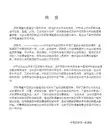
最新高中物理竞赛讲义(完整版)目录最新高中物理竞赛讲义(完整版) (1)第0部分绪言 (5)一、高中物理奥赛概况 (5)二、知识体系 (5)第一部分力&物体的平衡 (6)第一讲力的处理 (6)第二讲物体的平衡 (8)第三讲习题课 (9)第四讲摩擦角及其它 (13)第二部分牛顿运动定律 (15)第一讲牛顿三定律 (16)第二讲牛顿定律的应用 (16)第二讲配套例题选讲 (24)第三部分运动学 (24)第一讲基本知识介绍 (24)第二讲运动的合成与分解、相对运动 (26)第四部分曲线运动万有引力 (28)第一讲基本知识介绍 (28)第二讲重要模型与专题 (30)第三讲典型例题解析 (38)第五部分动量和能量 (38)第一讲基本知识介绍 (38)第二讲重要模型与专题 (40)第三讲典型例题解析 (53)第六部分振动和波 (53)第一讲基本知识介绍 (53)第二讲重要模型与专题 (57)第三讲典型例题解析 (66)第七部分热学 (66)一、分子动理论 (66)二、热现象和基本热力学定律 (68)三、理想气体 (70)四、相变 (77)五、固体和液体 (80)第八部分静电场 (81)第一讲基本知识介绍 (81)第二讲重要模型与专题 (84)第九部分稳恒电流 (95)第一讲基本知识介绍 (95)第二讲重要模型和专题 (98)第十部分磁场 (107)第一讲基本知识介绍 (107)第二讲典型例题解析 (111)第十一部分电磁感应 (117)第一讲、基本定律 (117)第二讲感生电动势 (120)第三讲自感、互感及其它 (124)第十二部分量子论 (127)第一节黑体辐射 (127)第二节光电效应 (130)第三节波粒二象性 (136)第四节测不准关系 (139)第0部分绪言一、高中物理奥赛概况1、国际(International Physics Olympiad 简称IPhO)① 1967年第一届,(波兰)华沙,只有五国参加。
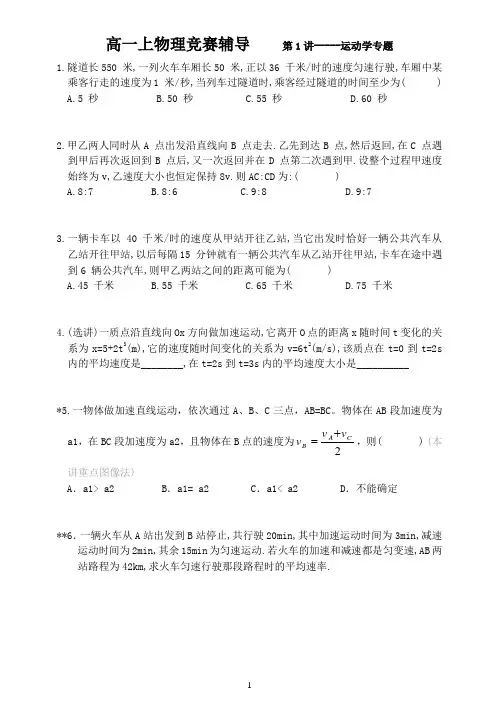
高一上物理竞赛辅导第1讲-----运动学专题1.隧道长550 米,一列火车车厢长50 米,正以36 千米/时的速度匀速行驶,车厢中某乘客行走的速度为1 米/秒,当列车过隧道时,乘客经过隧道的时间至少为( ) A.5 秒 B.50 秒 C.55 秒 D.60 秒2.甲乙两人同时从A 点出发沿直线向B 点走去.乙先到达B 点,然后返回,在C 点遇到甲后再次返回到B 点后,又一次返回并在D 点第二次遇到甲.设整个过程甲速度始终为v,乙速度大小也恒定保持8v.则AC:CD为:( )A.8:7B.8:6C.9:8D.9:73.一辆卡车以 40 千米/时的速度从甲站开往乙站,当它出发时恰好一辆公共汽车从乙站开往甲站,以后每隔15 分钟就有一辆公共汽车从乙站开往甲站,卡车在途中遇到6 辆公共汽车,则甲乙两站之间的距离可能为( )A.45 千米B.55 千米C.65 千米D.75 千米4.(选讲)一质点沿直线向Ox方向做加速运动,它离开O点的距离x随时间t变化的关系为x=5+2t3(m),它的速度随时间变化的关系为v=6t2(m/s),该质点在t=0到t=2s 内的平均速度是________,在t=2s到t=3s内的平均速度大小是__________*5.一物体做加速直线运动,依次通过A、B、C三点,AB=BC。
物体在AB段加速度为a1,在BC段加速度为a2,且物体在B点的速度为2CA B vv v +=,则( )(本讲重点图像法)A.a1> a2 B.a1= a2 C.a1< a2 D.不能确定**6.一辆火车从A站出发到B站停止,共行驶20min,其中加速运动时间为3min,减速运动时间为2min,其余15min为匀速运动.若火车的加速和减速都是匀变速,AB两站路程为42km,求火车匀速行驶那段路程时的平均速率.*7.蚂蚁离开巢沿直线爬行,它的速度与到蚁巢中心的距离成反比.当蚂蚁爬到距巢中心l1=1m 的A 点处时,速度是v1=2 cm/s.试问蚂蚁继续由A 点爬到距巢中心l2=2 m 的B 点需要多长的时间? (本讲重点图像法)8.在一静水湖的南北两岸,有两只船同时相向开出,各以其速度垂直于湖岸匀速驶向对岸。
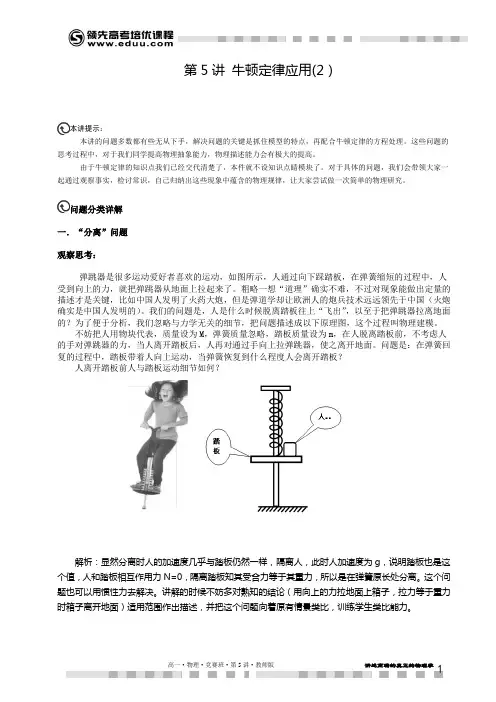
第5讲牛顿定律应用(2)本讲提示:本讲的问题多数都有些无从下手,解决问题的关键是抓住模型的特点,再配合牛顿定律的方程处理。
这些问题的思考过程中,对于我们同学提高物理抽象能力,物理描述能力会有极大的提高。
由于牛顿定律的知识点我们已经交代清楚了,本件就不设知识点睛模块了。
对于具体的问题,我们会带领大家一起通过观察事实,检讨常识,自己归纳出这些现象中蕴含的物理规律,让大家尝试做一次简单的物理研究。
问题分类详解一.“分离”问题观察思考:弹跳器是很多运动爱好者喜欢的运动,如图所示,人通过向下踩踏板,在弹簧缩短的过程中,人受到向上的力,就把弹跳器从地面上拉起来了。
粗略一想“道理”确实不难,不过对现象能做出定量的描述才是关键,比如中国人发明了火药大炮,但是弹道学却让欧洲人的炮兵技术远远领先于中国(火炮确实是中国人发明的)。
我们的问题是,人是什么时候脱离踏板往上“飞出”,以至于把弹跳器拉离地面的?为了便于分析,我们忽略与力学无关的细节,把问题描述成以下原理图,这个过程叫物理建模。
不妨把人用物块代表,质量设为M,弹簧质量忽略,踏板质量设为m,在人脱离踏板前,不考虑人的手对弹跳器的力,当人离开踏板后,人再对通过手向上拉弹跳器,使之离开地面。
问题是:在弹簧回复的过程中,踏板带着人向上运动,当弹簧恢复到什么程度人会离开踏板?人离开踏板前人与踏板运动细节如何?解析:显然分离时人的加速度几乎与踏板仍然一样,隔离人,此时人加速度为g,说明踏板也是这个值,人和踏板相互作用力N=0,隔离踏板知其受合力等于其重力,所以是在弹簧原长处分离。
这个问题也可以用惯性力去解决。
讲解的时候不妨多对熟知的结论(用向上的力拉地面上箱子,拉力等于重力时箱子离开地面)适用范围作出描述,并把这个问题向着原有情景类比,训练学生类比能力。
实战:【例1】一根劲度系数为k,质量不计的轻弹簧,上端固定,下端系一质量为m的物体,有一木板将物体托住,并使弹簧保持原长,如图所示.现让木板由静止以加速度a (a<g)匀加速向下运动,求经过多长时间木板与物体分离?解析:设物体与木板一起匀加速运动的距离为x时,木板与物体分离,它们之间的弹力为零makxmg=-且221atx=所以kaagmt)(2-=【例2】一弹簧秤的秤盘质量m1=1.5kg,盘内放一质量为m2=10.5kg的物体P,弹簧质量不计,其劲度系数为k=800N/m,系统处于静止状态,如图所示。
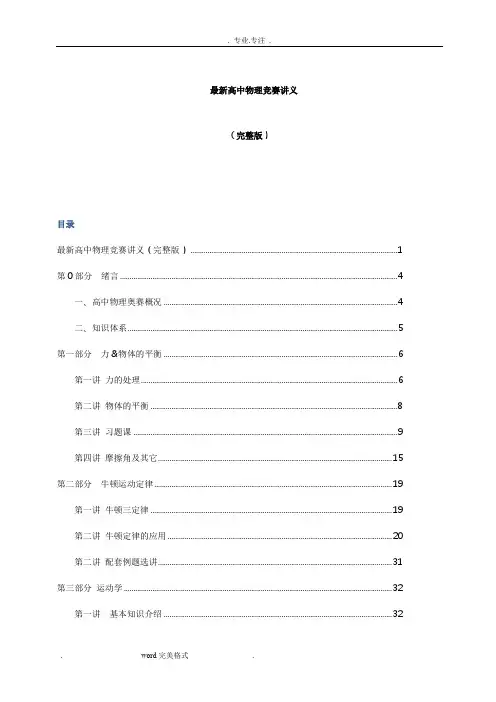
最新高中物理竞赛讲义(完整版)目录最新高中物理竞赛讲义(完整版) (1)第0部分绪言 (4)一、高中物理奥赛概况 (4)二、知识体系 (5)第一部分力&物体的平衡 (6)第一讲力的处理 (6)第二讲物体的平衡 (8)第三讲习题课 (9)第四讲摩擦角及其它 (15)第二部分牛顿运动定律 (19)第一讲牛顿三定律 (19)第二讲牛顿定律的应用 (20)第二讲配套例题选讲 (31)第三部分运动学 (32)第一讲基本知识介绍 (32)第二讲运动的合成与分解、相对运动 (34)第四部分曲线运动万有引力 (38)第一讲基本知识介绍 (38)第二讲重要模型与专题 (40)第三讲典型例题解析 (51)第五部分动量和能量 (51)第一讲基本知识介绍 (51)第二讲重要模型与专题 (54)第三讲典型例题解析 (71)第六部分振动和波 (71)第一讲基本知识介绍 (71)第二讲重要模型与专题 (77)第三讲典型例题解析 (89)第七部分热学 (89)一、分子动理论 (90)二、热现象和基本热力学定律 (92)三、理想气体 (95)四、相变 (104)五、固体和液体 (109)第八部分静电场 (111)第一讲基本知识介绍 (111)第二讲重要模型与专题 (116)第九部分稳恒电流 (130)第一讲基本知识介绍 (130)第二讲重要模型和专题 (135)第十部分磁场 (148)第一讲基本知识介绍 (148)第二讲典型例题解析 (153)第十一部分电磁感应 (160)第一讲、基本定律 (161)第二讲感生电动势 (165)第三讲自感、互感及其它 (170)第十二部分量子论 (174)第一节黑体辐射 (174)第二节光电效应 (178)第三节波粒二象性 (187)第四节测不准关系 (190)第0部分绪言一、高中物理奥赛概况1、国际(International Physics Olympiad 简称IPhO)①1967年第一届,(波兰)华沙,只有五国参加。

i 1i2 i 3几何光学是光学的一个古老的分支,也是物理学中最早被研究的分支。
据传,阿基米德 就已经掌握了光的反射定律。
当然,如今我们要面对的几何光学元件是远远要比平面镜复杂 的。
随着光学的发展,费马提出了以自己名字命名的定理,费马定理几乎可以概括整个集合 光学。
本讲就为大家详细地介绍几何光学。
一、全反射全反射光从密度媒质 1 射向光疏媒质 2,当入射角大于临界角 a = sin -1 n 生全反射。
二、多层介质折射 如图:多层介质折射率分别为 n 1 , n 2 , n 3 则由折射定律得: n 1 sin i 1 = n 2 sin i 2 = = n k sin i k三、球面折射成像时,光线发n 1n 2n 3 (1)球面折射成像公式(a )单介质球面折射成像如图所示,如果球面左、右方的折射率分别为 1 和 n , S ' 为 S 的像。
因为 i 、r 均很小,所以n R知识点睛本讲导学高二物理竞赛 第 5 讲 几何光学21例题精讲是球心,O 是顶点,球面曲率半径为 R ,S 是物点, S ' 是像点,对于近轴光线n 1i 1 = n 2i 2i 1 = α + β , i 2 = β - θ ,α =A 0 , β =uA 0,θ = A 0 R vn联立上式解得 1 u + n 2 v=n 2 - n 1r同时,我们可以算出,放大率为s ‘ ·n sn ′四、费马原理:光总选择光程取极值的路径五、惠更斯原理:惠更斯指出,由光源发出的光波,在同一时刻 t 时它所达到的各点的 集合所构成的面,叫做此时刻的波阵面(又称为波前),在同一波阵面上各点的相位 都相同,且波阵面上的各点又都作为新的波源向外发射子波, 子波相遇时可以互相叠加,历时△t 后,这些子波的包络面就是 t +△t 时刻的新的波阵面。
波的传播方向与波阵面垂直, 波阵面是一个平面的波叫做平面波,其传播方向与此平面垂 直,波阵面是一个球面(或球面的一部分)的波叫做球面波, 其传播方向为沿球面的半径方向,如图 六、二次曲线由于具有特殊的几何性质,在某些条件下可以理 想成像。

最新高中物理竞赛讲义(完整版)目录最新高中物理竞赛讲义(完整版) (1)第0部分绪言 (5)一、高中物理奥赛概况 (5)二、知识体系 (5)第一部分力&物体的平衡 (6)第一讲力的处理 (6)第二讲物体的平衡 (8)第三讲习题课 (9)第四讲摩擦角及其它 (13)第二部分牛顿运动定律 (15)第一讲牛顿三定律 (16)第二讲牛顿定律的应用 (16)第二讲配套例题选讲 (24)第三部分运动学 (24)第一讲基本知识介绍 (24)第二讲运动的合成与分解、相对运动 (26)第四部分曲线运动万有引力 (28)第一讲基本知识介绍 (28)第二讲重要模型与专题 (30)第三讲典型例题解析 (38)第五部分动量和能量 (38)第一讲基本知识介绍 (38)第二讲重要模型与专题 (40)第三讲典型例题解析 (53)第六部分振动和波 (53)第一讲基本知识介绍 (53)第二讲重要模型与专题 (57)第三讲典型例题解析 (66)第七部分热学 (66)一、分子动理论 (66)二、热现象和基本热力学定律 (68)三、理想气体 (70)四、相变 (77)五、固体和液体 (80)第八部分静电场 (81)第一讲基本知识介绍 (81)第二讲重要模型与专题 (84)第九部分稳恒电流 (95)第一讲基本知识介绍 (95)第二讲重要模型和专题 (98)第十部分磁场 (107)第一讲基本知识介绍 (107)第二讲典型例题解析 (111)第十一部分电磁感应 (117)第一讲、基本定律 (117)第二讲感生电动势 (120)第三讲自感、互感及其它 (124)第十二部分量子论 (127)第一节黑体辐射 (127)第二节光电效应 (130)第三节波粒二象性 (136)第四节测不准关系 (140)第0部分绪言一、高中物理奥赛概况1、国际(International Physics Olympiad 简称IPhO)① 1967年第一届,(波兰)华沙,只有五国参加。
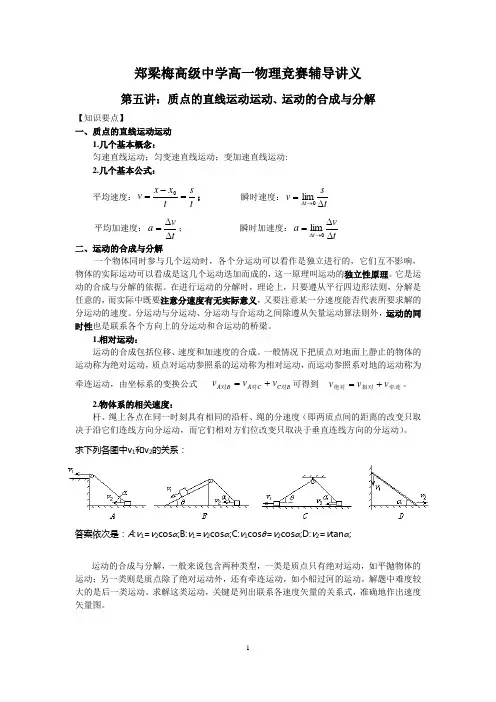
郑梁梅高级中学高一物理竞赛辅导讲义第五讲:质点的直线运动运动、运动的合成与分解【知识要点】一、质点的直线运动运动1.几个基本概念:匀速直线运动;匀变速直线运动;变加速直线运动: 2.几个基本公式:平均速度:ts tx x v =-=; 瞬时速度:ts v t ∆=→∆0lim平均加速度:tv a ∆∆=; 瞬时加速度:tv a t ∆∆=→∆0lim二、运动的合成与分解一个物体同时参与几个运动时,各个分运动可以看作是独立进行的,它们互不影响,物体的实际运动可以看成是这几个运动迭加而成的,这一原理叫运动的独立性原理。
它是运动的合成与分解的依据。
在进行运动的分解时,理论上,只要遵从平行四边形法则,分解是任意的,而实际中既要注意分速度有无实际意义,又要注意某一分速度能否代表所要求解的分运动的速度。
分运动与分运动、分运动与合运动之间除遵从矢量运动算法则外,运动的同时性也是联系各个方向上的分运动和合运动的桥梁。
1.相对运动:运动的合成包括位移、速度和加速度的合成。
一般情况下把质点对地面上静止的物体的运动称为绝对运动,质点对运动参照系的运动称为相对运动,而运动参照系对地的运动称为牵连运动,由坐标系的变换公式 B C C A B A v v v 对对对+=可得到 牵连相对绝对v v v +=。
2.物体系的相关速度:杆、绳上各点在同一时刻具有相同的沿杆、绳的分速度(即两质点间的距离的改变只取决于沿它们连线方向分运动,而它们相对方们位改变只取决于垂直连线方向的分运动)。
求下列各图中v 1和v 2的关系:答案依次是:A :v 1=v 2cos α;B:v 1=v 2cos α;C:v 1cos θ=v 2cos α;D:v 2=v tan α;运动的合成与分解,一般来说包含两种类型,一类是质点只有绝对运动,如平抛物体的运动;另一类则是质点除了绝对运动外,还有牵连运动,如小船过河的运动。
解题中难度较大的是后一类运动。
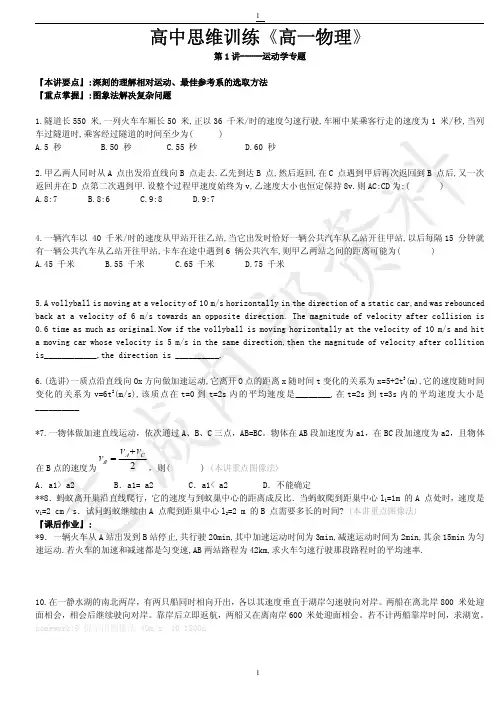
第1讲-----运动学专题『本讲要点』:深刻的理解相对运动、最佳参考系的选取方法『重点掌握』:图象法解决复杂问题1.隧道长550米,一列火车车厢长50米,正以36千米/时的速度匀速行驶,车厢中某乘客行走的速度为1米/秒,当列车过隧道时,乘客经过隧道的时间至少为()A.5A.8:7A.455.Aback is 0.6hit a在B=2v1为匀10.在一静水湖的南北两岸,有两只船同时相向开出,各以其速度垂直于湖岸匀速驶向对岸。
两船在离北岸800米处迎面相会,相会后继续驶向对岸。
靠岸后立即返航,两船又在离南岸600米处迎面相会。
若不计两船靠岸时间,求湖宽。
homework:9.提示用图像法40m/s10.1800m第2讲-----匀变速直线运动-----追击专题『本讲要点』:各类追击问题及其变形,掌握四种方法:公式法图像法二次函数法相对运动法『本章知识点概括』:匀变速直线运动的5个量:______、______、______、______、______外加1个量______,前5量任取3个可求另外两个123度为**4**5汽车的初速度是21v v <,此时汽车开始减速,加速度大小为2a 。
为了避免发生碰撞,摩托车也同时减速,求其加速度至少需要多少?『课后作业』:*6练习(追击问题变形)摩托车初速度为0,最大速度为30m/s,这辆摩托车以恒定的加速度追前方100m 处的汽车,汽车匀速运动,速度为20m/s.摩托车恰好用180s追上,求摩托车的加速度.7练习(追击问题变形):火车A速度为30m/s,正常刹车需要450m才能停下.火车司机突然发现前方100m 处有火车B在向前匀速行驶(AB同向),求B的速度至少为多大,两车才不相撞?(AB视为质点)高中思维训练《高一物理》第3讲-----自由落体-----双物体下落专题、1秒专题『本讲要点』:熟练掌握双物体下落过程两物理的位置、时间和速度的联系1例有一种测量楼高的方法:用一根长为L的绳,两端各系一个铁球.一个人手拿其中一个铁球(另一个球自然下垂),从楼顶让其自由下落,两铁球落地的时间差为t.求:(1)请用L,t,g表示出楼高h?(2)这种方法的不足之处在哪里?图:自己画2例小球A从高H处自由下落,与此同时,在小球A正下方的地面上,B小球以初速度V竖直上抛,不计空气阻力,设V=40m/s,g=10m/s2.求:⑴若要在B小球上升时两球相遇,则H的取值范围各是多少?⑵若要两小球在空中相遇,则H的取值范围又是多少?【方法一】先来看看B能上升多久,也就是在多少时间之内它的速度变为0,很显然:v=V0-gt,v=0,V0=40m/s,∴t=4s。
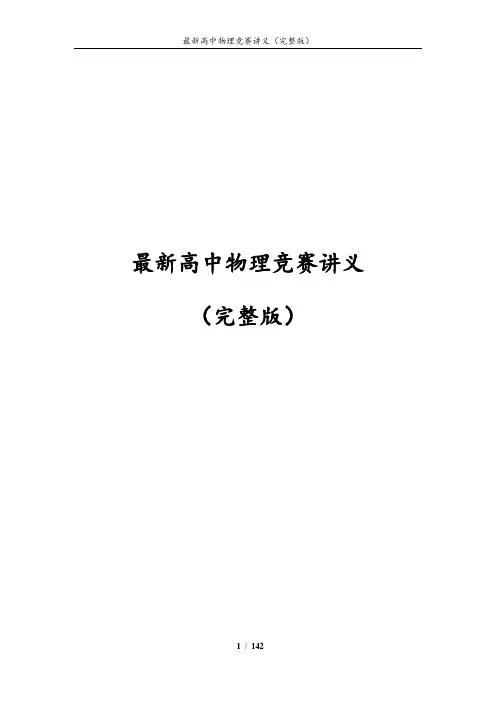
最新高中物理竞赛讲义(完整版)目录最新高中物理竞赛讲义(完整版) (1)第0部分绪言 (5)一、高中物理奥赛概况 (5)二、知识体系 (5)第一部分力&物体的平衡 (6)第一讲力的处理 (6)第二讲物体的平衡 (8)第三讲习题课 (9)第四讲摩擦角及其它 (13)第二部分牛顿运动定律 (15)第一讲牛顿三定律 (16)第二讲牛顿定律的应用 (16)第二讲配套例题选讲 (24)第三部分运动学 (24)第一讲基本知识介绍 (24)第二讲运动的合成与分解、相对运动 (26)第四部分曲线运动万有引力 (28)第一讲基本知识介绍 (28)第二讲重要模型与专题 (30)第三讲典型例题解析 (38)第五部分动量和能量 (38)第一讲基本知识介绍 (38)第二讲重要模型与专题 (40)第三讲典型例题解析 (53)第六部分振动和波 (53)第一讲基本知识介绍 (53)第二讲重要模型与专题 (57)第三讲典型例题解析 (66)第七部分热学 (66)一、分子动理论 (66)二、热现象和基本热力学定律 (68)三、理想气体 (70)四、相变 (77)五、固体和液体 (80)第八部分静电场 (81)第一讲基本知识介绍 (81)第二讲重要模型与专题 (84)第九部分稳恒电流 (95)第一讲基本知识介绍 (95)第二讲重要模型和专题 (98)第十部分磁场 (107)第一讲基本知识介绍 (107)第二讲典型例题解析 (111)第十一部分电磁感应 (117)第一讲、基本定律 (117)第二讲感生电动势 (120)第三讲自感、互感及其它 (124)第十二部分量子论 (127)第一节黑体辐射 (127)第二节光电效应 (130)第三节波粒二象性 (136)第四节测不准关系 (139)第0部分绪言一、高中物理奥赛概况1、国际(International Physics Olympiad 简称Ipoh)① 1967年第一届,(波兰)华沙,只有五国参加。
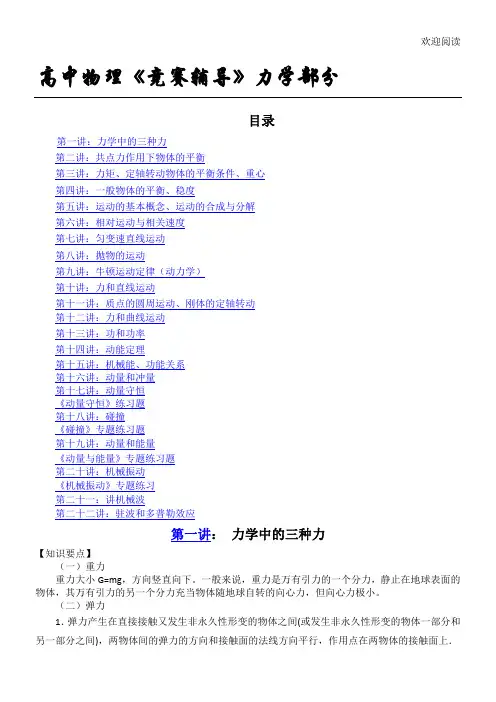
欢迎阅读高中物理《竞赛辅导》力学部分目录第一讲:力学中的三种力第二讲:共点力作用下物体的平衡第三讲:力矩、定轴转动物体的平衡条件、重心第二十二讲:驻波和多普勒效应第一讲:力学中的三种力【知识要点】(一)重力重力大小G=mg,方向竖直向下。
一般来说,重力是万有引力的一个分力,静止在地球表面的物体,其万有引力的另一个分力充当物体随地球自转的向心力,但向心力极小。
(二)弹力1.弹力产生在直接接触又发生非永久性形变的物体之间(或发生非永久性形变的物体一部分和另一部分之间),两物体间的弹力的方向和接触面的法线方向平行,作用点在两物体的接触面上.2.弹力的方向确定要根据实际情况而定.3.弹力的大小一般情况下不能计算,只能根据平衡法或动力学方法求得.但弹簧弹力的大小可用.f=kx(k 为弹簧劲度系数,x 为弹簧的拉伸或压缩量)来计算 .在高考中,弹簧弹力的计算往往是一根弹簧,而竞赛中经常扩展到弹簧组.例如:当劲度系数分别为k 1,k 2,…的若干个弹簧串联使用时.等效弹簧的劲度系数的倒数为:nk k k 1...111+=,即弹簧变软;反之.若以上弹簧并联使用时,弹簧的劲度系数为:k=k 1+…k n ,即弹簧变硬.(k=k 1+…k n长为0L 123.4定义φ0反力F '力特点;问题的一种典型方法。
【典型例题】【例题1】如图所示,一质量为m 的小木块静止在滑动摩擦因数为μ=33的水平面上,用一个与水平方向成θ角度的力F 拉着小木块做匀速直线运动,当θ角为多大时力F 最小? 【例题2】如图所示,有四块相同的滑块叠放起来置于水平桌面上,通过细绳和定滑轮相互联接起来.如果所有的接触面间的摩擦系数均为μ,每一滑块的质量均为m ,不计滑轮的摩擦.那么要拉动最上面一块滑块至少需要多大的水平拉力?如果有n块这样的滑块叠放起来,那么要拉动最上面的滑块,至少需多大的拉力?【例题3】如图所示,一质量为m=1㎏的小物块P静止在倾角为θ=30°的斜面上,用平行于斜面底边的力F=5N推小物块,使小物块恰好在斜面上匀速运动,试求小物块与斜面间的滑动摩擦因数(g取10m/s2)。
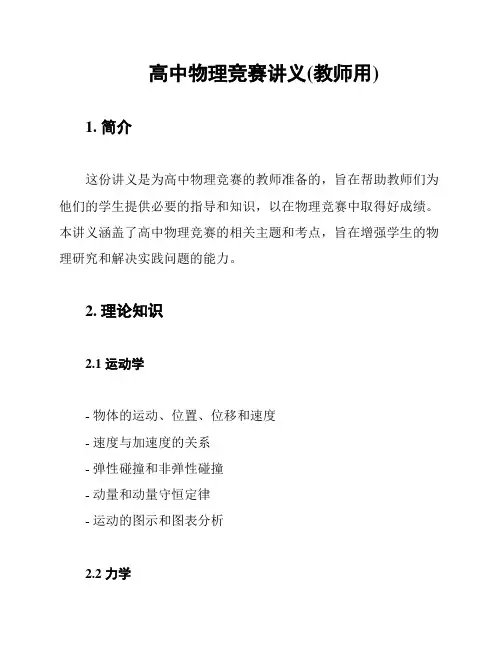
高中物理竞赛讲义(教师用)1. 简介这份讲义是为高中物理竞赛的教师准备的,旨在帮助教师们为他们的学生提供必要的指导和知识,以在物理竞赛中取得好成绩。
本讲义涵盖了高中物理竞赛的相关主题和考点,旨在增强学生的物理研究和解决实践问题的能力。
2. 理论知识2.1 运动学- 物体的运动、位置、位移和速度- 速度与加速度的关系- 弹性碰撞和非弹性碰撞- 动量和动量守恒定律- 运动的图示和图表分析2.2 力学- 牛顿三大定律- 重力和万有引力定律- 平衡和平衡力- 斜面上的物体- 力的图示和分析2.3 动力学- 动能和功- 功率- 机械能守恒- 弹性势能和势能- 摩擦力和摩擦系数2.4 光学- 光的传播和反射- 光的折射和折射定律- 光的成像和镜子- 光的波动性和光的粒子性- 光的干涉和衍射2.5 电学- 电荷和电场- 电势差和电势能- 电流和电路- 电阻和电阻率- 磁场和电磁感应3. 实践问题解决技巧3.1 解题方法- 阅读和理解问题- 利用已知信息建立方程- 运用适当的公式和定律- 进行数值计算和代入- 检查答案的合理性3.2 实验设计和数据处理- 选择适当的实验设计- 编制实验步骤和记录数据- 进行数据处理和分析- 得出结论并评估实验误差- 提出改进实验的建议4. 竞赛技巧- 熟悉竞赛规则和评分标准- 高效利用时间并掌握时间管理技巧- 提高问题理解能力和答题速度- 合理分配答题顺序和选择题目顺序- 注重细节和准确性,避免计算错误和拼写错误以上是本讲义的主要内容,希望能够帮助到教师们为高中物理竞赛的学生提供有效的指导和支持。
做好准备、提高学生的物理竞赛能力,是我们共同的目标。
祝愿所有参与的学生在竞赛中取得优异的成绩!。
最新高中物理竞赛讲义(完整版)目录最新高中物理竞赛讲义(完整版) (1)第0部分绪言 (3)一、高中物理奥赛概况 (3)二、知识体系 (3)第一部分力&物体的平衡 (4)第一讲力的处理 (4)第二讲物体的平衡 (6)第三讲习题课 (6)第四讲摩擦角及其它 (10)第二部分牛顿运动定律 (12)第一讲牛顿三定律 (12)第二讲牛顿定律的应用 (12)第二讲配套例题选讲 (19)第三部分运动学 (20)第一讲基本知识介绍 (20)第二讲运动的合成与分解、相对运动 (21)第四部分曲线运动万有引力 (23)第一讲基本知识介绍 (23)第二讲重要模型与专题 (24)第三讲典型例题解析 (32)第五部分动量和能量 (32)第一讲基本知识介绍 (32)第二讲重要模型与专题 (34)第三讲典型例题解析 (45)第六部分振动和波 (45)第一讲基本知识介绍 (45)第二讲重要模型与专题 (48)第三讲典型例题解析 (57)第七部分热学 (57)一、分子动理论 (57)二、热现象和基本热力学定律 (59)三、理想气体 (60)四、相变 (66)五、固体和液体 (70)第八部分静电场 (70)第一讲基本知识介绍 (70)第二讲重要模型与专题 (73)第九部分稳恒电流 (82)第一讲基本知识介绍 (82)第二讲重要模型和专题 (86)第十部分磁场 (94)第一讲基本知识介绍 (94)第二讲典型例题解析 (97)第十一部分电磁感应 (102)第一讲、基本定律 (102)第二讲感生电动势 (105)第三讲自感、互感及其它 (108)第十二部分量子论 (111)第一节黑体辐射 (111)第二节光电效应 (113)第三节波粒二象性 (119)第四节测不准关系 (122)第0部分绪言一、高中物理奥赛概况1、国际(International Physics Olympiad 简称IPhO)① 1967年第一届,(波兰)华沙,只有五国参加。
第5讲“沉浸在力的海洋。
”【温故知新】(5-10分钟)力是物体与物体之间的相互作用力可以使物体形变,也可以改变物体的运动状态[批注]:这部分是唤醒学生旧知的部分,通过图片、举例、选题,充分唤醒学生对于相关知识的记忆。
这讲中我选取的是生活中能遇到的与初中学过的知识有关的现象,通过这几个图片引起学生的熟悉感和参与度。
老师:同学们,你们还能记起初中所学的有关力的知识吗?【趣味引入】(5-10分钟)问:水为何从高处往低处流?答:因为物体受到重力问:撑杆跳利用的力是什么?答:弹力问:为何在粗糙的水平面上推物体要用力?答:因为物体受到摩擦力[批注]:这个环节是为了吸引学生的注意力,选取的例子需要有趣或者贴近生活,也可以能引起学生的参与,目的是引出我们这节课的知识点来。
通过总结生活中这些常见的现象,提问学生:那么哪位同学可以归纳下初中咱们所学重力,弹力,摩擦力的特点呢?【知识梳理】(25分钟左右)【说明】这节课主要让学生认识三大性质力,关于弹力和摩擦力的进一步应用涉及的不多,还有受力分析也涉及少,都可以引导学生在秋季的教学中进一步探讨。
一、力1、定义:物体与物体之间的相互作用1)物质性:力是物体间的相互作用。
有力必定有施力物体和受力物体。
2)相互性:物体间的作用是相互的。
A对B作用的同时B也对A也有作用,这两个力等大反向且在一条直线上。
3)力的矢量性:力不仅有大小,而且有方向,是矢量。
3、作用效果:1)力使物体的运动状态发生改变2)力是使物体产生形变的原因4、力的三要素:力的大小、方向和作用点5、力的图示:力的三要素:力的大小、方向和作用点力的示意图(只画出力的作用点和方向)6、作图步骤:1)选定合适的标度;2)从作用点沿力的方向画一线段,线段的长度由力的大小和所选标度确定;3)画上箭头(表示力的方向),注上F=80N。
二、重力1、定义:由于地球的吸引而使物体受到的力。
(施力物体是地球)重力的大小:1)测量:用弹簧秤测重力2)重力与质量的关系:G=mg①纬度越高,g越大;②同一纬度,高度越大,g越小。
高中物理《竞赛辅导》力学部分目录第一讲:力学中的三种力第二讲:共点力作用下物体的平衡第三讲:力矩、定轴转动物体的平衡条件、重心第四讲:一般物体的平衡、稳度第五讲:运动的基本概念、运动的合成与分解第六讲:相对运动与相关速度第七讲:匀变速直线运动第八讲:抛物的运动第九讲:牛顿运动定律(动力学)第十讲:力和直线运动第十一讲:质点的圆周运动、刚体的定轴转动第十二讲:力和曲线运动第十三讲:功和功率第十四讲:动能定理第十五讲:机械能、功能关系第十六讲:动量和冲量第十七讲:动量守恒《动量守恒》练习题第十八讲:碰撞《碰撞》专题练习题第十九讲:动量和能量《动量与能量》专题练习题第二十讲:机械振动《机械振动》专题练习第二十一:讲机械波第二十二讲:驻波和多普勒效应第一讲: 力学中的三种力【知识要点】(一)重力重力大小G=mg ,方向竖直向下。
一般来说,重力是万有引力的一个分力,静止在地球表面的物体,其万有引力的另一个分力充当物体随地球自转的向心力,但向心力极小。
(二)弹力1.弹力产生在直接接触又发生非永久性形变的物体之间(或发生非永久性形变的物体一部分和另一部分之间),两物体间的弹力的方向和接触面的法线方向平行,作用点在两物体的接触面上.2.弹力的方向确定要根据实际情况而定.3.弹力的大小一般情况下不能计算,只能根据平衡法或动力学方法求得.但弹簧弹力的大小可用.f=kx(k 为弹簧劲度系数,x 为弹簧的拉伸或压缩量)来计算 .在高考中,弹簧弹力的计算往往是一根弹簧,而竞赛中经常扩展到弹簧组.例如:当劲度系数分别为k 1,k 2,…的若干个弹簧串联使用时.等效弹簧的劲度系数的倒数为:nk k k 1...111+=,即弹簧变软;反之.若以上弹簧并联使用时,弹簧的劲度系数为:k=k 1+…k n ,即弹簧变硬.(k=k 1+…k n 适用于所有并联弹簧的原长相等;弹簧原长不相等时,应具体考虑) 长为0L 的弹簧的劲度系数为k ,则剪去一半后,剩余2L 的弹簧的劲度系数为2k (三)摩擦力 1.摩擦力一个物体在另一物体表面有相对运动或相对运动趋势时,产生的阻碍物体相对运动或相对运动趋势的力叫摩擦力。
最新高中物理竞赛讲义(完整版)目录最新高中物理竞赛讲义(完整版) (1)第0部分绪言 (5)一、高中物理奥赛概况 (5)二、知识体系 (5)第一部分力&物体的平衡 (6)第一讲力的处理 (6)第二讲物体的平衡 (8)第三讲习题课 (9)第四讲摩擦角及其它 (13)第二部分牛顿运动定律 (15)第一讲牛顿三定律 (16)第二讲牛顿定律的应用 (16)第二讲配套例题选讲 (24)第三部分运动学 (24)第一讲基本知识介绍 (24)第二讲运动的合成与分解、相对运动 (26)第四部分曲线运动万有引力 (28)第一讲基本知识介绍 (28)第二讲重要模型与专题 (30)第三讲典型例题解析 (38)第五部分动量和能量 (38)第一讲基本知识介绍 (38)第二讲重要模型与专题 (40)第三讲典型例题解析 (53)第六部分振动和波 (53)第一讲基本知识介绍 (53)第二讲重要模型与专题 (57)第三讲典型例题解析 (66)第七部分热学 (66)一、分子动理论 (66)二、热现象和基本热力学定律 (68)三、理想气体 (70)四、相变 (77)五、固体和液体 (80)第八部分静电场 (81)第一讲基本知识介绍 (81)第二讲重要模型与专题 (84)第九部分稳恒电流 (95)第一讲基本知识介绍 (95)第二讲重要模型和专题 (98)第十部分磁场 (107)第一讲基本知识介绍 (107)第二讲典型例题解析 (111)第十一部分电磁感应 (117)第一讲、基本定律 (117)第二讲感生电动势 (120)第三讲自感、互感及其它 (124)第十二部分量子论 (127)第一节黑体辐射 (127)第二节光电效应 (130)第三节波粒二象性 (136)第四节测不准关系 (139)第0部分绪言一、高中物理奥赛概况1、国际(International Physics Olympiad 简称IPhO)① 1967年第一届,(波兰)华沙,只有五国参加。
截止到目前,我们已经把运动学的主要框架知识都学习完了,但是从学完知识到灵活运用,还有很远的一段路程。
大家应该重点从公式和物理量的推导,方法,模型的总结几个方面去反复复习。
运动学思想方法总结:1.坐标系方法:坐标系是定量研究世界的一个非常重要的工具,利用坐标系可以很容易的定义物理量(比如,位置,位移,轨迹,速度,加速度等等),分析物理量之间的关系(最大,最小,曲率半径等等).坐标系方法除了我们学习过的正交分解和斜分解,还有以后会学习到的极坐标等等.要注意根据不同的例题采用不同的方法.【例1】 如图()a 所示,冰球沿与冰山底边成60β=︒的方向滚上山,上山初速度010m/s v =,它在冰山上痕迹已部分消失,尚存痕迹如图()b 所示,求冰山与水平面的夹角α(冰球在冰山上加速度为gsin α,方向沿着斜面向下,其中g 为重力加速度,近似取10m/s 2)。
【解析】 冰球在与冰山底边平行方向做匀速直线运动,0cos x v t β=⋅① 冰球在与冰山底边垂直方向做匀加速直线运动21sin 2y g t θ=⋅ ②由①②得2220sin 2cos g x y v θβ=⋅. 代入数据得1arcsin 302θ==︒.【例2】 如图所示,已知在倾角为θ的斜面上,以初速度0v 及与斜面成θ角的方向发射一小球,斜面与小球发生完全弹性碰撞,即小球的速度会被“镜面反射”.问:例题精讲知识点睛温馨寄语第5讲 运动学综合⑴ 小球恰能到原始出发点,问总时间t 总为多少? ⑵ 为了实现这个过程,θ必须满足什么条件?【解析】 小球若能回到出发点要求整个过程可逆,即在最右端可能有①②两种情况.①为最后一次与斜面碰撞角度为90︒. ②即在碰后小球进入竖直直线运动. 无论哪种情况,时间都满足:⑴ 02cos sin v t g θθ=总⑵ 只看垂直斜面速度002sin cos 2sin 212cos v n g t v n g θθθθ⎧⎪⎪=⎨+⎪⋅⎪⎩总,1234n =,,,……所以有22cos 21sin 2nn θθ⎧⎪=⎨+⎪⎩ 时都可以满足.【例3】 (摆线)一轮胎在水平地面上沿着一直线无滑动地滚动。
(这种情况下,轮胎边缘一点相对于轮胎中心的线速度等于轮胎中心对地的速率),轮胎中心以恒定的速率0v 向前移动,轮胎的半径为R ,在0t =时,轮胎边缘上的一点A 正好和地面上的O 点接触,试以O 为坐标原点,在如图的直角坐标系中写出轮胎上A 点的位矢、速度、加速度和时间的函数关系。
并写出A 的轨迹方程(可以用参数方程描述,也就是说,可以引入一个新的自变量,x 和y 都随着这个自变量的变化而变化。
最常见的参数方程,就是以时间t 为参数的。
)【解析】)sin(00Rtv R t v x -= )cos(0Rtv R R y -=【选讲内容】白努力家族大斗法:白努力家族(Bernoulli 家族)总共出过八个伟大的数学、物理、天文等等大师,还有很多画家、艺术家……白努力兄弟想比较一下谁更聪明。
于是就相约解决最速降线问题。
在当时比较牛逼的杂志上公开征集答案,他们各自提出了证明,杂志的主编,莱布尼茨也提出了证明,还有一个陌生人发来了一个有英国邮戳的证明…………肯定是牛顿…… 最后所有的证明中,Johann 的证明是最简洁明了了。
如下:AA 'Oxy0vJohann Bernoulli's solution约翰白努力的证明According to Fermat’s principle: The actual path between two points taken by a beam of light is the one which is traversed in the least time.Johann Bernoulli used this principle to derive the brachistochrone curve by considering the trajectory of a beam of light in a medium where the speed of light increases following a constant vertical acceleration (that of gravity g).[2]The conservation law can be used to express the speed of a body in a constant gravitational field as:,where y represents the vertical distance the body has fallen. By conservation of energy the speed of motion of the body along an arbitrary curve does not depend on the horizontal displacement.Johann Bernoulli noted that the law of refraction gives a constant of the motion for a beam of light in a medium of variable density:,where v m is the constant and represents the angle of the trajectory with respect to the vertical.The equations above allow us to draw two conclusions:1. At the onset, when the particle speed is nil, the angle must be nil. Hence, thebrachistochrone curve is tangent to the vertical at the origin.2. The speed reaches a maximum value when the trajectory becomes horizontal and the angleθ = 90°.To keep things simple we can assume that the particle (or the beam) with coordinates (x,y) departs from the point (0,0) and reaches maximum speed after a falling a vertical distance D.So,.Rearranging terms in the law of refraction and squaring gives:which can be solved for dx in terms of dy:.Substituting from the expressions for v and v m above gives:which is the differential equation of an inverted cycloid generated bya circle of diameter D【例4】一根长为l的均匀细杆可以绕通过其一端的水平轴O在竖直平面内转动,如图所示.杆最初在水平位置,杆上距O为a处放有一小物体(可视为质点),杆与其上小物体最初均处于静止状态.若此杆突然以匀角速ω绕O轴转动,设碰撞时细杆与水平面夹角为θ求B追上细杆时θ与ω的关系。
仅仅考虑ω比较小的情况。
【解析】⑴ 对这一问题首先如下分析:当细杆以角速ω绕O同转动时,B的速度为零,杆上与O接触处则具有线速度aω,因而两者分离,B作自由落体运动,由于B的速度不断增大,有可能追上细杆而与之碰撞,设碰撞时细杆与水平面夹角为θ,则θ随ω的增大而增大,当ω超过某一数值时,B就可能碰不上B而与之碰撞,所以本题要按这第一种情况进行讨论.⑵ 求B追上细杆时θ与ω的关系.设B经过时间t后与细杆在D处相碰(见图1),则有21tan2BD a gtθ==①tθω=②如给定ω的值,由此二式可求出相应的θ的值.由于杆长L的限制,要发生碰撞,θ值必须满足一定条件,由图1可知,此条件为arccosmaLθθ=≤③根据这一条件和ωθ-曲线,可以求出相应的ω的取值应符合的条件.由式①,②消去t得222tangaθωθ=或2tangaωθ=-④2.变换参考系.很多物理量在变换参考系的时候会有奇怪的性质发生.常见的有,位移,速度.变换到某些参考系之后,有的非圆周运动变成了圆周运动;某些不规则运动变成了竖直或者水平的运动.从而可以迅速解题.【例5】曲杆传动算得上机械史上一项伟大的发明,如图是汽缸中曲柄传动的应用,其变往复运动为例题精讲知识点睛圆周运动,现在把这个实物简化为右图的模型,设汽缸正以速度v 向下运动,角度如图所示,圆盘的半径为r ,计算圆盘转动的角速度ω。
【解析】 αβϕωcos )90cos(0v r =--所以)sin(cos αϕαω+=r v【例6】 缠在线轴上的线绕过滑轮B 后,以恒定速度0v 被拉出,如图所示,这时线轴沿水平面无滑动滚动,求线轴中心点O 的速度随线与水平方向的夹角α的变化关系(线轴的内、外半径分别为r 和R ).【解析】 线轴的运动可以看作是速度为v 的平动和角速度为ω的转动的合成,而且因为线轴不沿水平面滑动,有vRω= ①而A 点速度沿线方向的投影为0cos r v v ωα+= ②由①②得0cos v Rv r R α=+.【例7】 如图所示装置,设杆OA 以角速度ω绕O 转动,其A 端则系以绕过滑轮B 的绳,绳子的末端挂一重物M .已知OB h =,当OBA α∠=时,求物体M 的速度.【解析】 如右图所示,设90BAO β∠=︒+,A 点绕O 轴转动的速度A v 可表示为A v OA ω=⋅.将A v 分别为沿BA 方向的速度M v (因A 点与绳系在一起,故A v 有一分速度M v )和与M v 垂直的速度v ',则cos M A v v β=. 在ABO △中,由正弦定理得()sin 90sin cos h OA hβαβ==︒+.由此得sin M v h ωα=,此即物体M 的速度(绳上各点沿绳方向的速度大小均与物体M 的速度大小相同).解法二:相对角速度法,想象杆子是静止不动的,墙转动过来,则直接有: sin M v h ωα=3. 过程问题,小量分析,微元方法.微元法是高中竞赛必学的一个基本方法,它蕴含着微积分的基本思想之一:通过分析小量之间的关系来求得宏观的结论.应用微元方法的时候一定要注意,哪些量可以忽略(二阶小量),哪些量是不可以忽略的,一阶小量.4. 求极值,物理竞赛中用到的方法主要有:矢量几何方法求极值,二次函数极值,一元二次方程的0∆≥求极值,微元法求极值,均值定理求极值,利用导数求极值等等.知识点睛知识点睛【例8】体会一下什么是包络线:就是一个曲线可以把我们给定的图形围起来。